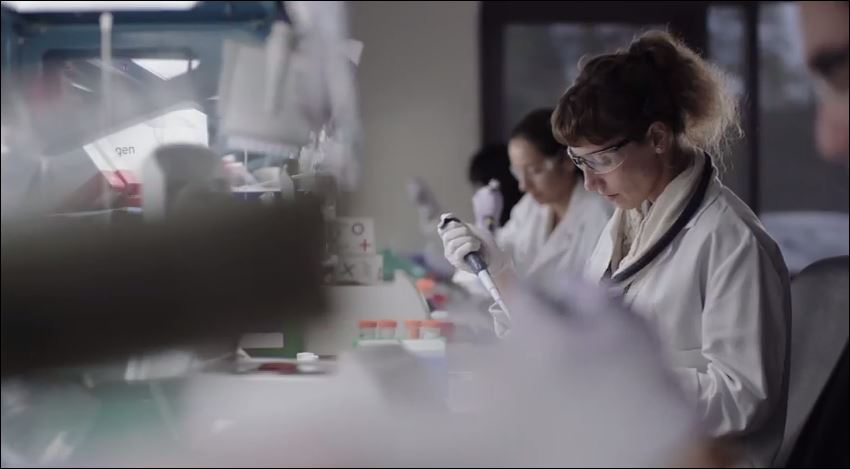Daily Business Report-Aug. 28, 2015
Scientists at work at a San Diego life science company.
Innovative Technology Companies
Are Driving San Diego’s Economy
Times of San Diego
Innovative technology companies account for just over 11 percent of local jobs, but pay double the average wage and are leading San Diego’s economic growth.
That is the conclusion of a report released Thursday by the National University System Institute for Policy Research that examined the strengths of San Diego’s innovation economy.
“Among the 25 largest metro areas in the nation, San Diego stands alone as the most diverse technologically concentrated region,” said Kelly Cunningham, economist and senior fellow.
In a comparison of eight general sectors of technology employment defined by the Census Bureau, only San Diego had seven technology concentrated sectors. San Francisco and Seattle follow with five sectors each.
Cunnningham’s’s team found the following levels of employment in different tech sectors in 2014:
Biotech/Pharmaceuticals/Biomedical — 33,423
Software — 28,782
Communications Equipment — 27,822
Defense and Transportaiton — 24,029
Environmental Technology — 10,905
Computers and Electronics — 10,598
Other Tech Consulting Services — 9,436
Recreational Goods — 2,296
“San Diego’s significant diversity and strength among technology endeavors is a powerful force driving the regional economy. Technical diversity is particularly advantageous as technologies converge,” Cunningham said. “For example, the merging of telecommunications with biomed diagnostic equipment and computer and electronic monitoring systems has immense possibilities and advantages with each technology cluster having strong concentrations in San Diego. ”
As of 2014, technology companies accounted for 11.1 percent of payroll jobs and 22 percent of total wages. The average wage of workers employed by technology companies is $114,300, 2.3 times higher than the average of non-tech San Diego companies at $49,700.
In addition to paying higher wages, companies in the technology sectors are adding more jobs. Tech company payrolls increased 7.1 percent in 2014, versus 4.7 percent for other sectors.
Click here for the full report.
__________________________________________________________

Navy Broadway Project Clears Coastal Hurdle
San Diego Union-Tribune
The long-awaited redevelopment of the Navy’s downtown waterfront property cleared its next-to-last hurdle Thursday with the announcement of a settlement between the Navy and the California Coastal Commission.
The commission dropped its lawsuit seeking to reconsider the $1.2 billion, 3.25-million-square-foot plan in exchange for new concessions from the developer, Doug Manchester, former owner of The San Diego Union-Tribune.
Manchester consultant Perry Dealy said the agreement leaves one more legal impediment to starting construction Manchester Pacific Gateway on the 12-acre site between Pacific Highway, Broadway and Harbor Drive.
The project would include 2.9 million square feet of office space, including a 351,000-square-foot regional headquarters for the Navy; 1,375 hotel rooms; a 40,000-square-foot museum; 213,000 square feet of retail and restaurant space; more than 3,100 parking spaces; and a 1.9 acre public park at the corner of Broadway and Harbor Drive. All would be built on land granted to the Navy by city voters in 1920 and leased in 2006 by the Navy to Manchester for 99 years.

Only 3 Local Water Districts
Missed July Drought Targets
City News Service
San Diego County residents continued their strong conservation measures last month, with only three local water districts exceeding state-mandated cutback targets.
The largest water distributor in the region, the city of San Diego, saw a 29 percent reduction in July, compared to July 2013, the standard set by state water officials. The conservation target for San Diego is 16 percent over 2013 monthly figures.
Cumulatively, San Diegans cut back on water use by 27 percent between June and July.
Statewide, the reduction was just over 31 percent, beating Gov. Jerry Brown’s call for a 25 percent reduction as California faces a fourth straight year of drought.
Customers in the Fallbrook Public Utilities District missed their state-assigned conservation target of 36 percent last month after cutting back consumption by 31 percent. Cumulatively, Fallbrook customers saved 28 percent between June and July.
The other two San Diego-area water agencies that exceeded their assigned targets last month didn’t miss by much.
Residents and businesses in the North County community of Rainbow, also with a target of 36 percent, reduced use by 35 percent. The cumulative total was 28 percent.
In the San Dieguito district, customers saved 26 percent, two percentage points shy of the goal. The cumulative total was just 22 percent.
The city of Carlsbad exceeded its conservation target of 28 percent by one point last month, but the June-July combined total of 27 percent fell slightly short.
The state reported the following figures for other local districts, with July’s reduction, the cumulative total, and conservation target:
— Santa Fe Irrigation, 48 percent, 43 percent, 36 percent.
Los Angeles Company Buys
San Diego Daily Transcript
City News Service
The San Diego Daily Transcript announced Thursday that it has been purchased by the Los Angeles-based Daily Journal Corp., which operates small business and legal newspapers around California and Arizona.
In July, the 130-year-old newspaper announced that it would stop producing its print edition at the beginning of September, and continue its online operation for a few weeks before shutting that down, as well. Publisher Robert Loomis cited increasing costs and the “changing publishing paradigm” for the move.
The Daily Journal purchased the Daily Transcript’s name and masthead and certain other assets, and will begin publishing under the SDDT banner Sept. 2, according to Thursday’s announcement.
The Daily Journal Corp. did not immediately respond to a request for comment. The company also operates the San Diego Commerce newspaper.
According to the Transcript’s website, its roots go back to 1882, when it began publishing as the National City Record. It changed names through a variety of owners, and took on the Transcript name in 1886.
Southwestern and Point Loma Nazarene
Partner on Bachelor’s Degree Programs
City News Service
Southwester College announced a partnership Thursday with Point Loma Nazarene University that will allow students to pursue bachelor’s degrees in four fields of study without having to leave the South Bay area.
Four-year degree programs in nursing and criminal justice are scheduled to begin next month, according to officials with the community college. Management and relational development, and child and adolescent development will begin in the spring.
Combined, the four programs will accommodate up to 200 students.
“Southwestern College prides itself on its commitment to student success through a wide range of academic and workforce training programs, and this new partnership with Point Loma Nazarene University furthers the options available to our students,” said Melinda Nish, the college’s president.
Students interested in one of the programs can view the PLNU website at www.pointloma.edu, or visit Yvette Miranda at the main Southwestern campus, Room 545A, according to the college.

EvoNexus Graduates 10
More Startup Companies
Times of San Diego
The EvoNexus incubator graduated 10 more startup companies on Thursday night, bringing the total since 2009 to 105 firms that have raised more than $670 million in funding.
The companies — which ranged from point-of-sale loans to Uber-like truck sharing to 3D-printer software — presented their businesses to a capacity crowd of 300 at the Rady School of Management at UC San Diego.
“Startups are not for the faint of heart,” said EvoNexus CEO Rory Moore before introducing the presenting teams. “Startups are something you do when you’re totally committed.”
Among the 10 companies that presented were:
Loan Hero — The company offers technology to make it easier to consumers to get point-of-sale loans. It has aready funded $1.6 million in loans. “We’re here to help people and make money,” said Founder and COO Kristin Sink.
Astroprint — An open software platform for the 3D-printer world that makes it easy for consumers to print objects.
Qelzal — Object-avoidance technology for commercial drones. The first product helps drones avoid airliners and other manned aircraft. “Qelzal will become the mobile eye of the drone industry,” said CEO Olivier Coenen.
GoShare — A truck-sharing network for moving heavy items. “So far, our customers love us,” said CEO Shaun Savage.
CollectiveSun — Provides solar power installations for nonprofits through a crowd-lending platform. Founder Lee Barken said nonprofits have been left out of the solar-power revolution because they cannot benefit from tax credits.
Wrapify — Crowd-sourced advertising campaigns with vehicle wraps.
Dotstudioz — Revenue-generating tools for online video producers on YouTube and other networks. The company’s goal is to “empower the digital storytellers of tomorrow.”
Using cellphones, the crowd voted Wrapify the winning presenter, but Moore pointed out that it was a close tally.
After the presentations, the teams met with venture capital firms that could provide financing.
EvoNexus admits a new class of companies twice a year, providing space and mentoring at no charge in Downtown San Diego, the University Town Center area and in Irvine.
Legislation to Make San Diego River
Conservancy Permanent Advances
Legislation by Assembly Speaker Toni Atkins that makes the San Diego River Conservancy permanent passed the Senate Appropriations Committee on Thursday.
“The San Diego River Conservancy has established its value in the region over the past 13 years,” said Atkins (D-San Diego). “The conservancy has allocated $20 million in state funds for the watershed while leveraging millions more in federal, local and private funds. AB 392 would extend the San Diego River Conservancy indefinitely, strengthening this resource for generations to come.”
Currently, the Conservancy would sunset on Jan. 1, 2020. Eight of the 10 existing state conservancies in California are permanent. The San Diego River Conservancy was created in 2002 and, since then, has overseen more than 100 acres of restoration along the river, construction and renovation of approximately 15 miles of public trails and acquisition of over 200 acres of land from willing sellers.
Having a permanent conservancy in place makes sense given the time needed to oversee proposed projects that will be in progress past the current sunset date, according to Atkins. Proposition 1, approved by the voters in 2014, includes $17 million for work in the conservancy’s watershed, with projects estimated to take five to 10 years to complete. Grantees must then be monitored for compliance with grant conditions for up to 25 years.
NSA Certifies ViaSat Inc.
Security System on a Chip
ViaSat Inc., a global broadband services and technology company, announced that the National Security Agency (NSA) has certified its KOV-55 Security-System-on-a-Chip to secure voice and data up to the Top Secret level for Multifunctional Information Distribution System Low-Volume Terminals (MIDS LVT) operating over a Link 16 network. This is the first certification of its kind, paving the way for Link 16 crypto modernization to enable secure interoperability with legacy and future combat networking waveforms.
The NSA certification effort was completed on-schedule under ViaSat’s contract with the U.S. Space and Naval Warfare Systems Command’s (SPAWAR) MIDS Program Office, which includes the design, development and production of approximately 10,000 units.


